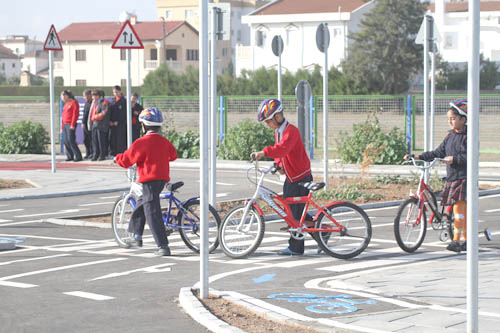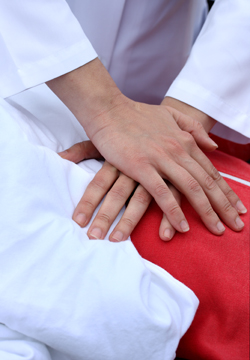|
 Frequently Asked
Questions Frequently Asked
Questions
How Does Excessive Speed Create Fatal Risk?

Traffic accidents due to excessive speed and
violation of speed limit consist 13% of all
accidents in the world. Driving with excessive speed
is also a major reason of fatality in traffic
accidents.
This is mainly due to rules of phsics:
As the speed increases, distance to stop after brake
extends, its gets harder to control the steering
wheel especially for turns, and tyre performance to
hold the road decreases.
Besides such deterioration decreasing dirvers's capability to control the
car, time left for driver to react in case of a
potential risk decreases too; so does for the other
drivers around.
Crash severity increases. High collision speed
simply means more kinetic energy, and more impact
force on the human body, which may cause fatality.
Speed and angle of views are
inversely proportional. A stopping person has
140
degree
viewing angle,
however, it decreases to
70 degrees,
if he is travelling at
65km/h;
and
to 30 degrees
at 130
km/h.
This angle is just enough to watch the movements on the
road, which is not sufficient for safe driving. A
driver
must be able to see and get prepared for vehicles
coming from side roads or for people or animals that
may run in to road from side roads or pavements.
Only 1 km/h increase in
speed means 3% increase in accident risk, and
accordingly injury or fatality risk.
Resource:
Kürşat ÇUBUK and Seda HATİPOĞLU
Traffic Planning and Enforcement; Gazi Üniv. Eng.
Arc. Fac. Jounal. Volume 21, No 4, 699-702, 2006
How does Seat-Belt Save Life?
In case of a collision, the car stops in the first
ten mili-seconds. However, if they are not fastened by
seat-belts, the passengers inside the car will
continue to move at the collision speed until they
stop by hitting the steering wheel, control panel or the
windshield. This means any object or human being
inside the car will be stopped by hitting some rigid
object.
Seat-belt,
1. Dampens the force of the impact on the human
body,
2. Diverts the collision impact to most powerful
parts of the body,
3. Distributes the collision impact over various
parts of the body and prevents it to be borne by
just one point,
4. Prevents you to be thrown out from your seat,
5. Protects the vital organs like head (brain),
spinal cord and chest (heart) from getting injured.
 If you don't wear seat-belts, it is impossible to
stay in your position by holding some part of the
car in case of a crash. Even if you achieve to hold
somewhere in miliseconds, the force of impact may
break your arms or legs used for holding yourself.
As arm muscles can stand maximum 25 kgf, the
force an impact of hitting a wall at 50 km/h would
generate is at least 3 times more. Seat-belts
are designed to bear these loads. If you don't use
seat-belt or fasten your child with a child
restraint, it is impossible to protect your body or
the child from getting jerked to the sides or front
of the car by holding. If you don't wear seat-belts, it is impossible to
stay in your position by holding some part of the
car in case of a crash. Even if you achieve to hold
somewhere in miliseconds, the force of impact may
break your arms or legs used for holding yourself.
As arm muscles can stand maximum 25 kgf, the
force an impact of hitting a wall at 50 km/h would
generate is at least 3 times more. Seat-belts
are designed to bear these loads. If you don't use
seat-belt or fasten your child with a child
restraint, it is impossible to protect your body or
the child from getting jerked to the sides or front
of the car by holding.
On the other side, many people say they would prefer
flying out of the vehicle. This is wrong. Statistics show
that the safest place in case of a crash is
inside of the vehicle, as you can not be sure how
you will land once you fly out. It seems risk of fatality increases
by 25 times, if passengers fly out of the car.
How does information on
First-Aid save life?
More lives get lost while removing passengers from
the car or transferring to a hospital than those
lost just at the moment of crash. First-aid
information on how to keep the injured
in correct positions, to maintain breathing,
to prevent shock, and to stop bleeding may save
lives until the medical team arrive the scene.
However, it should be kept in mind that first-aid is
just a precaution taken at the scene to keep the
injured alive. It is not a treatment. It starts
with ensuring safety at the crash scene and ends by transferring the
injured via an ambulance.
Why is using a mobile phone while driving is a
serious factor causing accidents? It is
because it distractive and impairs the
concentration of the driver. Besides, allocating one
hand to mobile phone, causes some physical
restraints to control the car and this decreases
maneuvre capability.
Drivers make more mistakes while they are using
mobile phones. They are either not aware or late
to be aware of some dangerous situations. Researches
indicate such delay changes between 0.6 and 0.9
seconds depending on the age of the driver. Such a
delay in braking at 60 km/h speed means
15m more distance to stop.
Worse than this is not to be aware of dangers. It is
experimentally found that during a simple
conversation with 20% probability and during a busy
conversation with 29% probability drivers may miss
dangerous cases.
Using a mobile phone is not only dangerous during
dialling or talking. It keeps mind busy also while
waiting for a call or for a certain duration after
the call, and so increases accident risk. In an
experiement done over 699 drivers, it is found that
in 5 minutes following a busy conversation, accident
risk increases by 4.8 and in 15 minutes by 1.3 fold.
Another issue verified by various researches is that
hands-free equipment used for mobile phones while
driving does not help much. Because, it is the
subject of the conversation that keeps mind busy and
distracts attention, which is the major factor for a
traffic accident to occur.
Meanings of traffic
signs
Traffic W
Traffic Arrangement Signs
Traffic Information Signs
Waiting and Parking
Signs
Motorway Signs
Road Line Signs
Over Pavement Lines
and Signs
Information about the
traffic tickets currently in force:
Driving under the influence
of alcohol:
Level of alcohol in blood - up to 50-100 mgr: 618.5 TL
fine and 100 penalty points
Driving a public car under the influence of alcohol
or level of alcohol in blood exceeds 100 mgr (101
and more): 1.237 TL fine and 100 penalty points.
Violation of speed limits:
Violation by up to 20 km/h : 123.5 TL fine and 5
penalty points
Violation by 20-40 km/h :
185.6 TL fine 25 penalty points
Violation by more than 40 km/h :
309.3 TL fine and 50 penalty points
Not wearing seat-belt :
247.4 TL fine and 15 penalty points
Violation of traffic signs:
123.7 TL fine and 15 penalty points
Violation of traffic lights :
247.4 TL fine and 30 penalty points
|


 If you don't wear seat-belts, it is impossible to
stay in your position by holding some part of the
car in case of a crash. Even if you achieve to hold
somewhere in miliseconds, the force of impact may
break your arms or legs used for holding yourself.
As arm muscles can stand maximum 25 kgf, the
force an impact of hitting a wall at 50 km/h would
generate is at least 3 times more. Seat-belts
are designed to bear these loads. If you don't use
seat-belt or fasten your child with a child
restraint, it is impossible to protect your body or
the child from getting jerked to the sides or front
of the car by holding.
If you don't wear seat-belts, it is impossible to
stay in your position by holding some part of the
car in case of a crash. Even if you achieve to hold
somewhere in miliseconds, the force of impact may
break your arms or legs used for holding yourself.
As arm muscles can stand maximum 25 kgf, the
force an impact of hitting a wall at 50 km/h would
generate is at least 3 times more. Seat-belts
are designed to bear these loads. If you don't use
seat-belt or fasten your child with a child
restraint, it is impossible to protect your body or
the child from getting jerked to the sides or front
of the car by holding.
